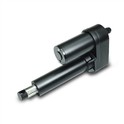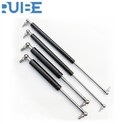Salon chairs are essential fixtures in beauty salons, barbershops, and other grooming establishments. One of the key components that contribute to the functionality and comfort of these chairs is the gas spring. As a salon chair gas spring supplier, I often get asked about the materials used to make these crucial parts. In this blog post, I'll delve into the various materials that go into the production of salon chair gas springs, their properties, and why they are selected.
Steel
Steel is one of the most commonly used materials in the manufacturing of salon chair gas springs. It is known for its high strength and durability, which are essential qualities for a component that will be subjected to repeated use and stress.
Carbon Steel
Carbon steel is a type of steel that contains carbon as the main alloying element. It is relatively inexpensive and easy to form, making it a popular choice for the outer tube of gas springs. Carbon steel provides good structural support and can withstand the pressure exerted by the gas inside the spring. However, it is prone to rust and corrosion, especially in humid environments. To combat this, carbon steel components are often coated with a protective layer, such as zinc or chrome.
Stainless Steel
Stainless steel is another steel alloy that is widely used in gas spring production. It contains chromium, which forms a passive oxide layer on the surface of the steel, preventing rust and corrosion. Stainless steel is more expensive than carbon steel but offers superior resistance to environmental factors, making it ideal for use in high - end salon chairs or in areas with high humidity. It also has a sleek and modern appearance, which can enhance the aesthetic appeal of the chair.
Aluminum
Aluminum is a lightweight metal that is increasingly being used in the manufacturing of salon chair gas springs. It has a high strength - to - weight ratio, which means that it can provide the necessary support while reducing the overall weight of the chair. This is particularly beneficial for portable or adjustable salon chairs, as it makes them easier to move and reposition.
Aluminum is also resistant to corrosion, which is an important property for a component that may come into contact with water or cleaning agents. Additionally, it is relatively easy to machine and can be anodized to improve its surface hardness and appearance. However, aluminum is not as strong as steel, so it may not be suitable for applications that require high load - bearing capacity.


Seals and O - Rings
Seals and O - rings are critical components of a salon chair gas spring as they prevent the leakage of gas and oil from the spring. These parts are typically made from elastomeric materials, such as rubber or silicone.
Rubber
Rubber is a common material for seals and O - rings due to its excellent elasticity and sealing properties. It can conform to irregular surfaces and create a tight seal, preventing the escape of gas or fluid. There are different types of rubber, such as nitrile rubber (NBR) and ethylene propylene diene monomer (EPDM). NBR is resistant to oil and fuel, making it suitable for use in gas springs that contain hydraulic fluid. EPDM, on the other hand, has good resistance to weathering, ozone, and high temperatures, making it a good choice for outdoor or high - temperature applications.
Silicone
Silicone is another elastomeric material used for seals and O - rings. It has a wide temperature range, from very low to very high temperatures, and is resistant to aging, UV radiation, and chemicals. Silicone seals are often used in applications where a high degree of flexibility and durability is required. They are also known for their low compression set, which means that they can maintain their sealing properties over a long period of time.
Gas and Oil
The internal working of a salon chair gas spring relies on a combination of gas and oil.
Gas
The gas used in most gas springs is nitrogen. Nitrogen is an inert gas, which means that it does not react with other materials inside the spring. It is non - flammable and has good compressibility, which allows the spring to absorb and release energy smoothly. The pressure of the nitrogen gas inside the spring determines the force required to compress or extend the spring, and this can be adjusted during the manufacturing process to meet the specific requirements of the salon chair.
Oil
Oil is used in gas springs to lubricate the moving parts and dampen the movement of the piston. It helps to reduce friction and wear, which extends the lifespan of the spring. The type of oil used depends on the operating conditions of the gas spring. For example, in high - temperature applications, a high - viscosity oil may be used to ensure proper lubrication.
Applications and Related Products
Salon chair gas springs are just one type of gas spring among many. If you are interested in other applications, we also supply related products such as Lockable Gas Spring for Desk and Gas Struts for Medical Bed. Our Gas Spring for Chair is designed to provide smooth and reliable adjustment for various types of chairs, not just salon chairs.
Why Choose Our Salon Chair Gas Springs
As a supplier, we take pride in using high - quality materials in the production of our salon chair gas springs. We understand that the performance and durability of these components are crucial for the overall quality of the salon chair. Our gas springs are rigorously tested to ensure that they meet or exceed industry standards.
We also offer a range of customization options, allowing us to provide gas springs that are tailored to the specific needs of our customers. Whether you need a gas spring with a specific load capacity, stroke length, or finish, we can work with you to develop the perfect solution.
Contact Us for Purchase and Negotiation
If you are in the market for salon chair gas springs or have any questions about our products, we encourage you to contact us. Our team of experts is ready to assist you with your inquiries and provide you with detailed information about our products and services. We are committed to providing the best quality products at competitive prices, and we look forward to the opportunity to work with you.
References
- "Handbook of Materials Selection" by Michael F. Ashby
- "Gas Spring Design and Application" by various industry experts






